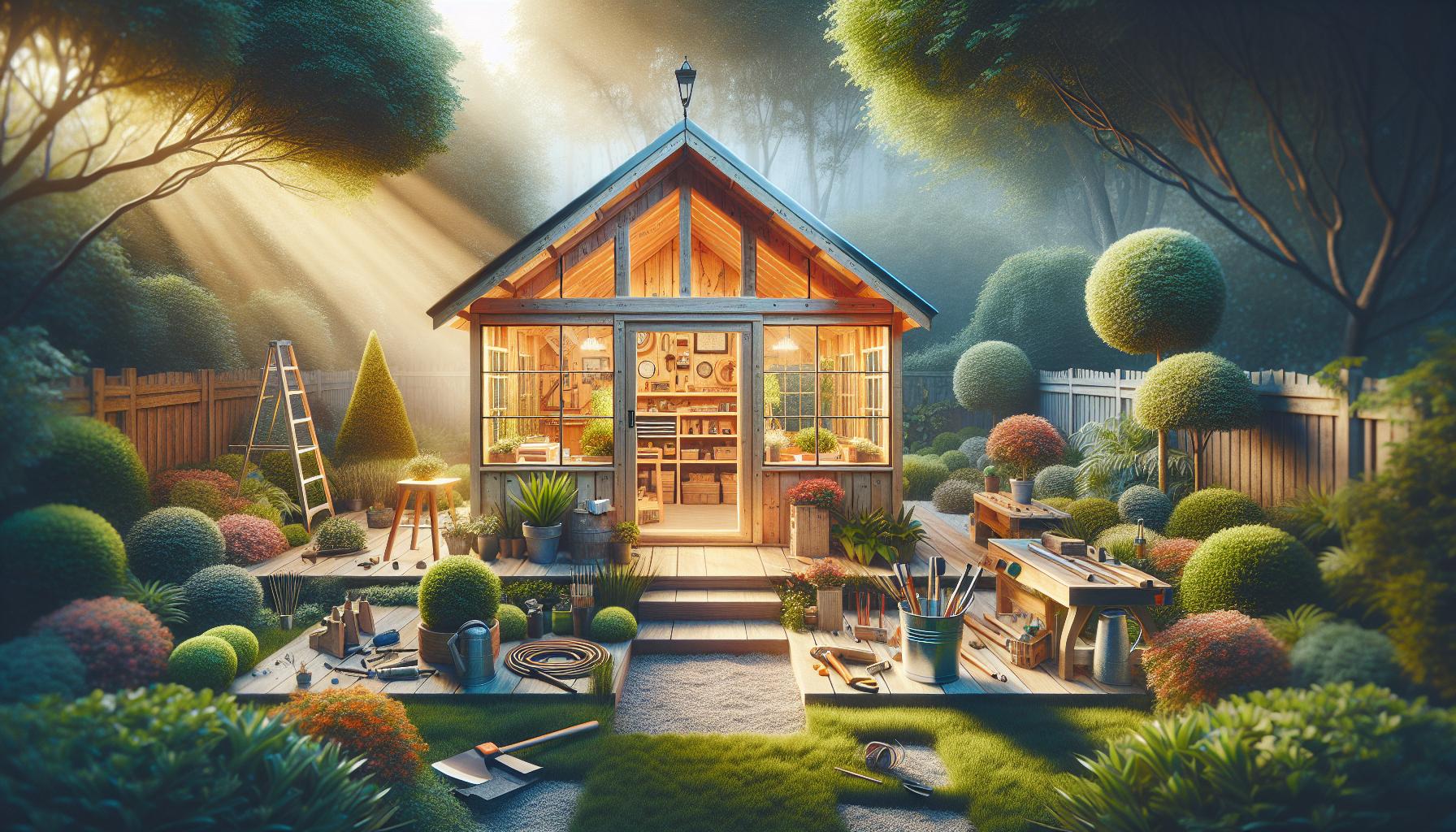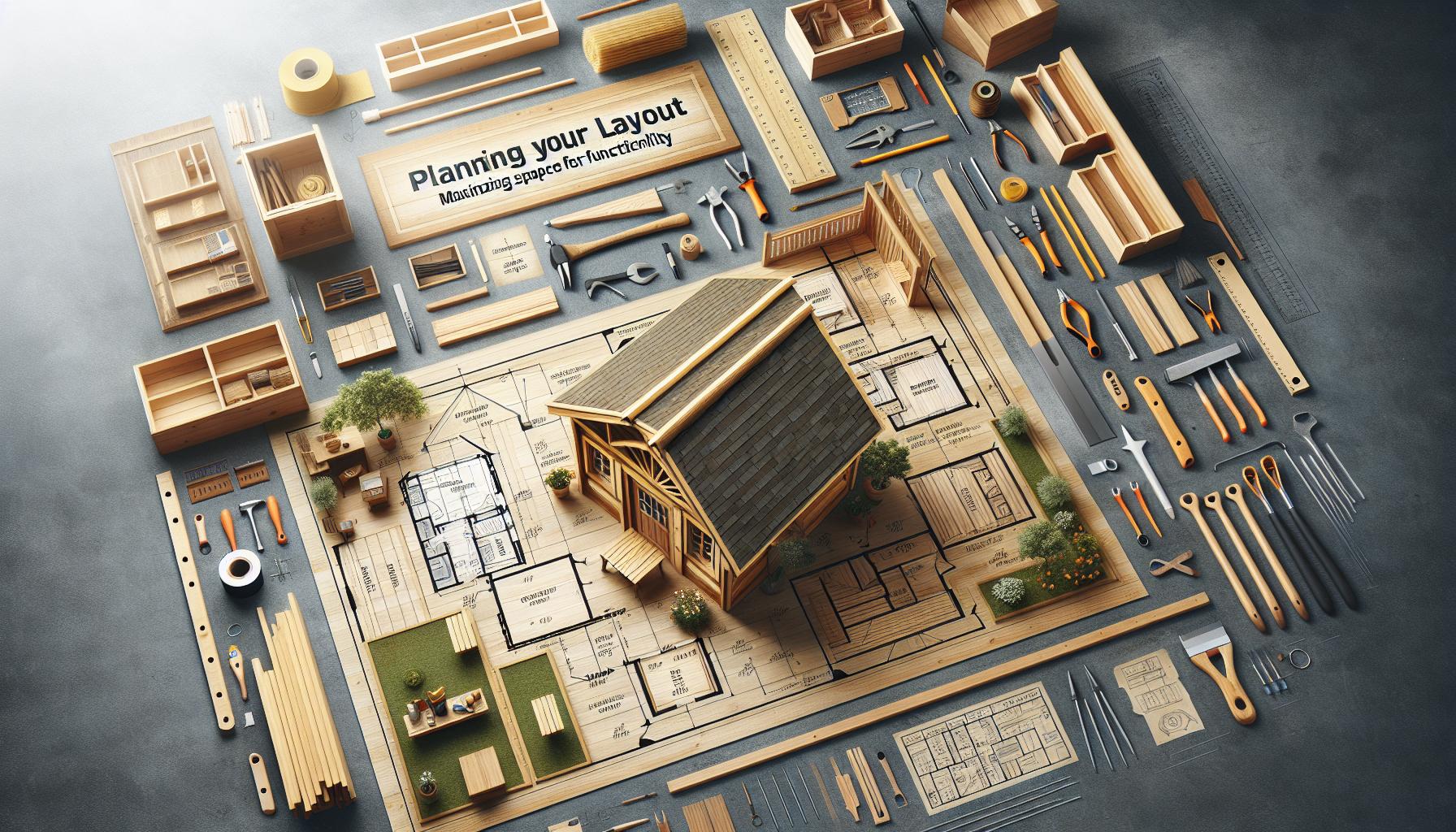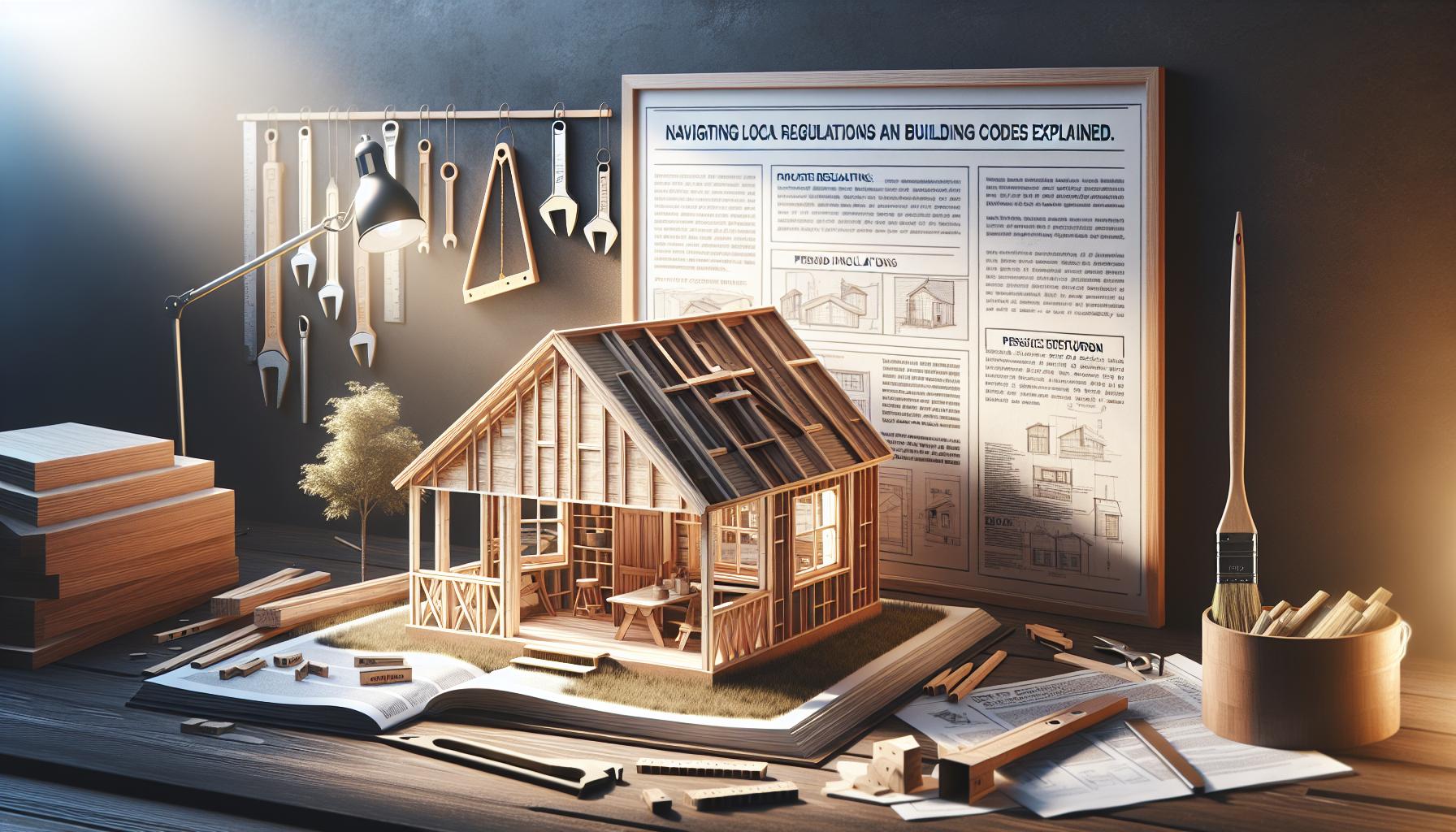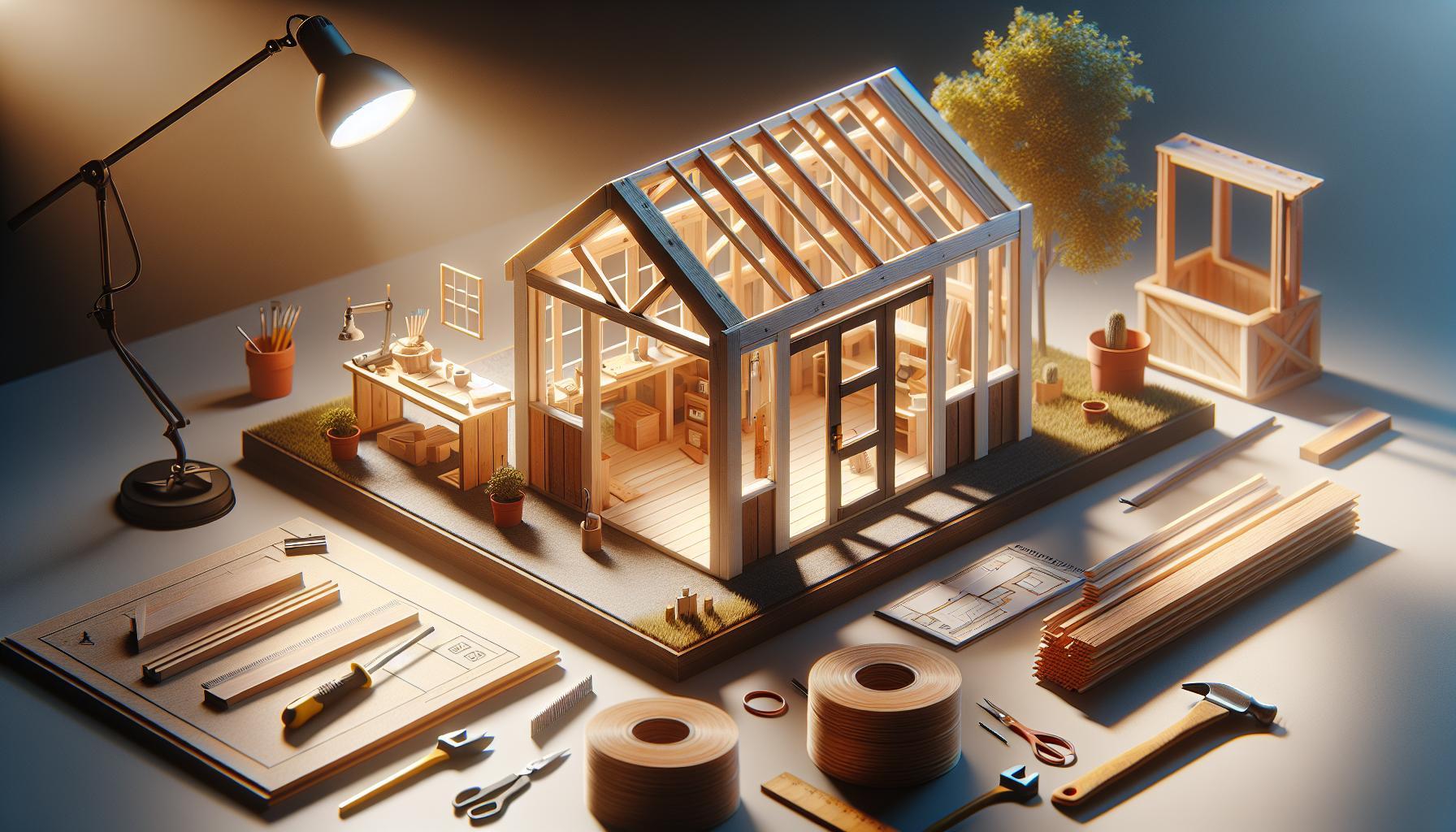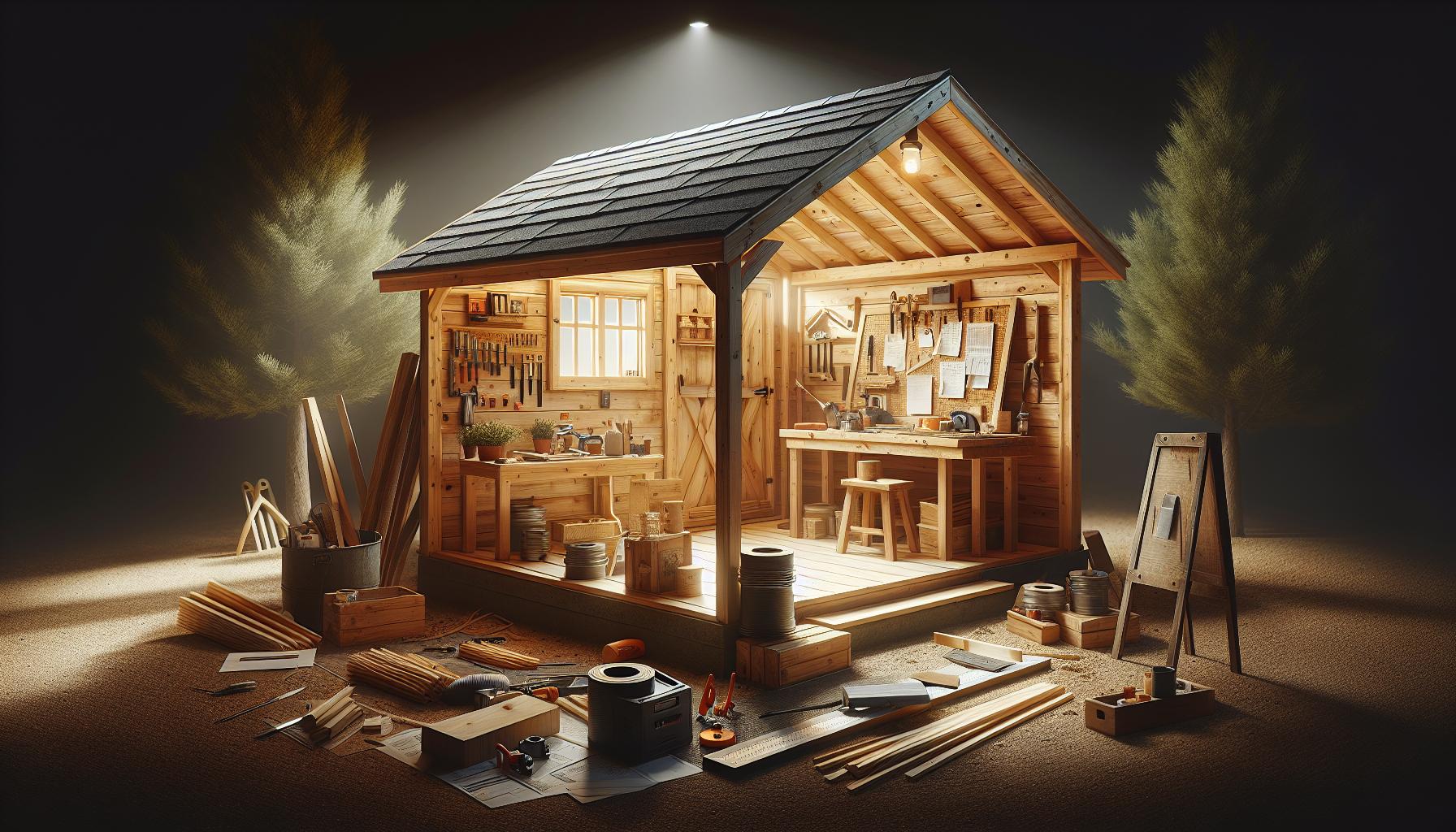Are you dreaming of a garden shed but unsure if you can pull it off? Building a functional adn stylish outdoor space is not only achievable but can also enhance your gardening experience. This guide will walk you through the essentials of creating the perfect storage for tools and equipment, making your green-thumb dreams a reality.
Understanding Your Garden Shed Needs: What to consider Before You Build
When planning to construct a garden shed, many homeowners find themselves pondering a single pivotal question: what do I truly need from this space? A well-designed shed can enhance the organization of your gardening tools, serve as a workshop, or even provide storage for seasonal decorations. Understanding your garden shed needs begins with a thorough evaluation of intended uses, available space, and your personal style preferences.
Assessing Your Requirements
Before diving into the building process, consider these key factors to ensure your garden shed meets your specific needs:
- Purpose: Define what you will primarily use the shed for—whether it’s for storing tools, potting plants, or even as a small greenhouse.
- Space Availability: Measure your yard to determine how much space you can allocate for the shed without squishing your garden or pathways.
- Materials and Style: Reflect on the aesthetics of your home and garden; consider whether you prefer a traditional wooden shed, a modern metal structure, or something in between.
- Future Growth: Think long-term. Will you need additional space in the future? Planning ahead can save you from the hassle of modifications later.
Determining Size and Layout
Onc you have a solid understanding of your needs, the next critical step is deciding the size and layout of the shed. It’s important to create a design that maximizes efficiency while maintaining an inviting atmosphere.
| Size | Recommended Use |
|---|---|
| 6×8 ft | Ideal for tool storage and small gardening supplies. |
| 8×10 ft | Good for a potting shed or a small workshop setup. |
| 10×12 ft | Perfect for larger equipment, extensive gardening supplies, or hobby workshops. |
| 12×16 ft or larger | Great for multi-purpose use, accommodating larger equipment, and providing workspace. |
Designing your garden shed with multi-functionality in mind can significantly enhance its utility. Consider versatile shelving, hook racks for tools, and even a workbench that folds away when not in use. Additionally, integrating windows can provide natural light, essential for plant care, and increase ventilation, making your shed a more pleasant place to work.
As you gather ideas and finalize your shed needs, remember that this investment in your outdoor space should reflect both functionality and harmony with your garden. Taking the time to thoughtfully plan your garden shed will ensure it becomes a cherished part of your green-thumb experience.
Choosing the Right Location: Finding the Perfect Spot for Your Shed
Finding the ideal spot for your garden shed is more than just a matter of convenience; it can significantly enhance your gardening experience and overall yard aesthetics. The right location can provide easy access to your tools, ensure that your shed blends harmoniously with your landscape, and maximize natural light for better usage. As you weigh the question of whether you can build a garden shed, consider these essential factors that guide the decision-making process.
Assess Your Garden Layout
Before you choose a location, take stock of your garden’s layout. Think about how you currently use your outdoor space and what your future plans might include. Here are key aspects to consider:
- Accessibility: Ensure that the shed is easy to reach, especially when carrying heavy tools or supplies.
- Proximity to Garden Beds: Position your shed close to the areas where you’ll need tools most frequently, making it easier to tend to your plants.
- Sunlight Exposure: Decide whether you want the shed to be fully shaded or to receive some sunlight which can keep tools dry and prevent rust.
Evaluate the Terrain
The physical characteristics of your property play a crucial role in your shed’s placement. Here are some terrain-related factors you should assess:
- Drainage: Avoid low-lying areas that collect water or are prone to flooding. A shed on wet ground can lead to structural problems over time.
- Soil Type: Check whether the soil is rocky, sandy, or clay-heavy, as this could affect your ability to lay a solid foundation.
- Elevation: Opt for a slightly elevated area to prevent water pooling around the shed’s base.
Local Regulations and Aesthetics
Once you have a few promising locations in mind, it’s essential to consider any local regulations and aesthetic elements:
- Zoning Laws: Always check your local zoning regulations to ensure your shed complies with building codes, including setback requirements.
- Visual Impact: Think about how the shed will look from different angles of your yard and from your home. You may prefer a position that doesn’t obstruct gorgeous views.
- Surrounding Flora: Position the shed away from larger trees to mitigate risks of branches falling and also to avoid excessive shade that could hinder growth of nearby plants.
By thoughtfully considering these factors while planning your shed’s location, you’re setting the groundwork for a functional and visually appealing addition to your garden sanctuary. The insights gained from evaluating these criteria will make your garden shed a more delightful and practical space, perfectly aligning with the goals outlined in your journey to discover if you can build a garden shed.
Materials Matter: Selecting Sustainable and Durable Options
When considering the construction of a garden shed, the materials you choose play a crucial role not only in sustainability but also in the longevity and aesthetic appeal of the structure. Using sustainable materials reduces environmental impact and enhances the durability of your shed, making it a smart investment for any gardener looking to harmonize their love for nature with practical building choices. In today’s eco-conscious world, opting for materials that are both responsible and durable can elevate your garden shed from a simple storage solution to a sustainable retreat.
Choosing Sustainable Materials
When exploring options, prioritize materials that are renewable, recycled, or sourced sustainably. Here are key categories to consider:
- Wood: Look for reclaimed wood or certified sustainably sourced timber (like FSC-certified). These options not only reduce waste but also provide a rustic charm to your garden shed.
- recycled Materials: incorporating materials like recycled metal for roofing or siding can significantly lower your shed’s carbon footprint. Recycled products frequently enough have a unique aesthetic, adding character to your structure.
- Natural insulation: Materials such as sheep’s wool, cellulose, or straw bales can provide excellent insulation while being biodegradable and non-toxic.
Durability and Maintenance
Selecting sustainable materials also means considering their durability.As an example, fiber-cement siding or composite decking can withstand the elements better than traditional wood, requiring less maintenance over time. This not only extends the life of your garden shed but also reduces the need for repairs and replacements, aligning with the ethos of eco-kind living. Here’s a quick comparison of some sustainable materials in terms of durability and maintenance:
| Material | Durability | Maintenance |
|---|---|---|
| Reclaimed Wood | High | Moderate (requires sealing) |
| Recycled Metal | Very High | Low (rust-resistant options available) |
| Natural Insulation | High | Low (non-toxic treatment) |
| Composite Decking | High | Low (easy cleaning) |
By carefully selecting sustainable and durable materials, you are ensuring that your garden shed not only serves its purpose effectively but also remains a beatiful and eco-friendly feature in your outdoor space. Remember, the choices you make in materials can lead to a thriving surroundings for your plants and a space that reflects your values, making your garden shed an inspiring cornerstone of your gardening efforts as highlighted in *Can I build a Garden Shed: Green-Thumb’s Guide to the Perfect Space*.
Essential Tools and Supplies: Gear Up for Success
Building a garden shed is a rewarding project that not only enhances your outdoor space but also provides a dedicated area for tools,supplies,and gardening activities. However, to turn your vision into reality, it’s essential to have the right tools and supplies at your disposal. With the right gear, you can transform your shed from a simple structure into a fully functional haven for all your gardening ambitions.
Must-Have Tools for Building Your Shed
Equipping yourself with a solid selection of tools is the frist step toward constructing the perfect garden shed. Here’s a breakdown of essential tools you will need:
- Measuring Tape: Accurate measurements ensure a properly sized shed. Invest in a retractable measuring tape for convenience.
- level: A spirit level will help you maintain even foundations and walls, which is crucial for stability.
- power drill: This versatile tool is necessary for fast assembly and can make quick work of drilling holes and driving screws.
- Saw: Depending on your choice of materials, a circular saw or a hand saw will be essential for cutting lumber to size.
- hammer: Ideal for manually assembling pieces, a reliable hammer is a must-have for any building project.
Essential Supplies for Construction
Once you have your tools lined up, stock up on the necessary supplies.Choosing the right materials enhances durability and functionality, so consider the following:
| supply | Description |
|---|---|
| Wood (Plywood/Pressure-Treated Lumber) | Lightweight yet sturdy, these options are perfect for creating both the frame and walls of your shed. |
| Nails/Screws | A variety of sizes is crucial for different structural elements. Opt for corrosion-resistant types if your shed will be exposed to moisture. |
| Roofing Materials | Asphalt shingles or metal roofing can offer excellent protection from the elements. Select materials that match your aesthetic preferences. |
| Paint or Wood Stain | These not only enhance the appearance of your shed but also offer essential weatherproofing. |
Gathering these tools and supplies is a critical foundation for embarking on your journey to building a garden shed. With the right equipment,you’ll be well on your way to crafting a space that not only meets your gardening needs but also becomes a cherished part of your yard. Embrace the excitement of not just asking, “Can I build a garden shed?” but taking actionable steps towards making it happen!
Planning Your Layout: Maximizing Space for Functionality
When embarking on the journey of building your garden shed, one of the most pivotal stages is planning the layout. A well-thought-out design not only maximizes space but also enhances the overall functionality of your shed, ultimately paving the way for a more enjoyable gardening experience. Did you no that the average garden shed can frequently enough hold more than just tools? With the right layout, it can transform into a multi-functional haven tailored to your gardening needs.
To start, consider your primary goals for the space. Do you envision a workshop, a storage area for your tools, or a cozy nook to tend to your plants? Identifying your objectives will guide your design choices. Here’s a practical method to plan your layout effectively:
Key Considerations for Your Shed’s Layout
- Functionality: Think about what activities you’ll be performing most often. will you need a potting bench, shelving for tool organization, or a space for seed-starting trays?
- Accessibility: Ensure that your most-used tools and supplies are easily reachable. A well-organized system where frequently used items are at hand can save you time and effort.
- Natural Light: Windows can dramatically improve your workspace. Planning for light can invigorate your shed and make it a pleasant place to spend time.
- Ventilation: Adequate airflow helps prevent mold and humidity build-up, important for both you and your plants.
One effective approach to maximize space is through vertical storage solutions. Utilizing walls for shelves and hooks allows you to free up valuable floor space. Consider implementing a multi-level storage system or pegboard for tools and small items, ensuring they are organized and visible.
Example Layout Ideas
To illustrate how you can effectively use space, we provide a basic layout example:
| Area | Description |
|---|---|
| Entryway | Space for hanging coats and storing shoes, keeping the main area tidy. |
| Work Bench | A sturdy surface for potting and repairs; ideally positioned near natural light. |
| Storage Shelves | Along the walls for holding pots, soil, tools, and supplies, with labels for easy identification. |
| Seed Starting Station | Well-ventilated and close to a light source to promote healthy plant growth. |
By mapping out your space considering these aspects, you can create a garden shed that truly meets your needs. Remember, the goal is to create a layout that is both functional and inspiring, allowing your green thumb to flourish in an organized and efficient environment. As you reflect on the insights from “Can I Build a Garden Shed: Green-Thumb’s Guide to the Perfect space,” envision how your design choices will enhance your gardening adventures.
Navigating Local Regulations: Permits and Building Codes Explained
Understanding the intricacies of local regulations can often feel as daunting as the construction project itself. Having a vision of your dream garden shed is one thing, but navigating permits and building codes is where many enthusiasts stumble. Before you break ground on your garden shed, it’s essential to engage with your local government’s regulations to ensure that your new structure keeps you on the right side of the law and harmonizes with neighborhood aesthetics.
types of permits you may Need
Several types of permits might be required based on your location and the specifications of your garden shed. Being informed about these can save you from potential headaches down the road. Here are the most common types:
- Building Permit: This is often the most critical permit, required for any significant construction. It ensures your structure meets safety and zoning standards.
- Zoning Permit: This checks that your shed fits within land-use regulations. Zones may dictate the shed’s size or its distance from property lines.
- Variance Requests: If your shed design doesn’t meet existing zoning ordinances, you may need to apply for a variance, which allows exceptions to current regulations.
Understanding Building Codes
Building codes can vary widely from one municipality to another, but their central goal is safety. familiarizing yourself with these codes can help to create a structure that is both beautiful and secure. Here are some key aspects to consider while planning:
- Structural Integrity: Ensure your shed can withstand local weather conditions, including wind and snow loads.
- Electrical and Plumbing Codes: If your shed will feature electricity or plumbing, comply with codes that govern installation and safety.
- Fire Safety Regulations: Some areas have specific measures to prevent fire hazards, particularly if your shed is close to flammable vegetation.
Steps to Take Before You Build
To simplify the process, consider these actionable steps before you begin your garden shed project:
| Step | Action | Details |
|---|---|---|
| 1 | Research Local Regulations | Visit your local government’s website or office to find out about specific permits and codes required. |
| 2 | Prepare Your Plans | Create a detailed plan that includes dimensions, materials, and any utilities if applicable. |
| 3 | Obtain Necessary Permits | Submit your plans along with permit applications to the appropriate local authorities. |
| 4 | Schedule Inspections | During the construction process, schedule inspections to ensure compliance with building codes. |
Arming yourself with knowledge about local regulations and building codes will not only smooth the path to getting your shed built but also ensure your masterpiece stands strong and sturdy for years to come. The ultimate goal is to create a garden space that complements your landscape while keeping within the legal parameters set forth by local authorities, ultimately facilitating a harmonious neighborhood ambiance as you embark on this rewarding project.
Step-by-Step Assembly: Bringing Your Vision to Life
Imagine stepping into your very own garden sanctuary, where tools are neatly organized, and plants thrive under your careful watch. Building that garden shed can be a dream turned reality, and with careful planning and a little elbow grease, you can bring your vision to life. the process of assembly is where your initial ideas transform into a tangible environment that supports your gardening endeavors.
To start, it’s vital to have a solid blueprint in hand. Your plans should specify dimensions, window placements, and door configurations. Begin your project with the foundation, which is the backbone of your shed. A sturdy foundation ensures longevity and stability, so whether you choose a concrete slab or a wooden base, make sure it’s perfectly leveled. Once the foundation is in place,you can begin constructing the walls.
Building the Frame
As you proceed, focus on framing your walls. Use pressure-treated lumber for durability and resistance to moisture. Here’s a concise checklist of materials you’ll need for the frame:
- 2×4 or 2×6 lumber for wall studs
- OSB or plywood for the sheathing
- Nails or screws for assembly
- Angle brackets for added support
Start by creating the wall sections on the ground before raising them into position.This technique allows for easier handling and ensures a sturdy attachment at the corners.
Assembling the Roof and Final Touches
Once the walls are up, it’s time to work on the roof. Choose a roof style that complements your garden design—gabled, flat, or shed-style roofs each have their unique aesthetics and benefits. Ensure to incorporate proper insulation and ventilation to protect your gardening tools and plants from moisture build-up.
When adding the finishing touches, think about the functionality and aesthetics of your shed. Apply weather-resistant paint or wood stain to protect against the elements, and consider installing shelves and hooks to keep everything organized.
A Quick Reference Table for Shed Materials
| Material | Purpose | Recommended Type |
|---|---|---|
| Foundation | Stability and Support | Concrete / Pressure-treated wood |
| Walls | Structure and Security | 2×4 or 2×6 lumber |
| Roof | Protection from Elements | Metal / Asphalt shingles |
| Paint/Stain | Aesthetic and Protection | Weather-resistant exterior paint |
by following these practical steps, you’ll be well on your way to creating a space that not only supports your gardening activities but also reflects your personal style. Remember, the satisfaction of standing in a shed you’ve built with your own hands will be as rewarding as the beautiful plants you cultivate inside it.
Personalizing Your Shed: Tips for Adding Character and Function
transforming a simple garden shed into a personalized retreat can enhance not only its functionality but also your gardening experience. In fact, a well-designed shed can serve as a multipurpose space, accommodating both storage and leisure. Imagine stepping into your backyard not just to tend to your plants, but to enjoy a cozy spot for relaxation, creativity, or even hosting friends.Here are some practical tips to infuse character and utility into your shed, making it a beloved part of your gardening journey.
Add Color and Style
One of the easiest ways to personalize your shed is through exterior and interior paint. Choose colors that either complement your garden or reflect your personality. For inspiration, consider the following ideas:
- Bright and Cheerful: Bright yellows, blues, and greens can evoke a sense of happiness and vitality.
- Earthy Tones: Subdued colors like sage green or terracotta can create a natural,harmonious blend with your outdoor surroundings.
- Chalkboard Paint: Use chalkboard paint on one wall for notes, sketches, or reminders, merging function with fun.
optimize Functionality with Smart Organization
Transform your shed into an efficient workspace by utilizing smart organization systems. Here are practical solutions:
- Vertical Storage: Install wall-mounted shelves or pegboards to keep tools, pots, and supplies accessible and off the floor.
- Cabinets and Bins: Use labeled bins and cabinets to categorize your gardening tools, making it easy to locate items quickly.
- Potting Station: Consider creating a dedicated potting area with a sturdy table and storage for soil and pots.
Incorporate Greenery
Bringing nature inside your shed can create a soothing atmosphere.Adding plants not only enhances aesthetics but also improves air quality.Try these ideas:
- Hanging Plants: Use hooks to hang cascading plants from the ceiling or rafters.
- Window Boxes: If your shed has windows, consider planting window boxes filled with herbs or flowers to welcome pollinators.
- Vertical Garden Wall: Create a living wall where you can grow small pots of succulents or herbs, adding life to your shed.
Make It Comfortable
To enjoy your shed as a workspace or a retreat, turning it into a comfortable escape is essential.Whether it’s for enjoying morning coffee or unwinding after a day in the garden, consider these enhancements:
- Seating: Add a cozy chair or a small bench for rest breaks. For a more playful touch, consider outdoor cushions or beanbags.
- Lighting: Install fairy lights or LED strips to create a welcoming ambiance in the evenings.
- Decor: Personalize with garden-themed artwork or photographs that inspire your gardening journey.
By implementing these tips, your garden shed can evolve from a mere storage space into a well-loved and functional part of your garden realm. Each detail adds character, turning the question of “Can I build a garden shed?” into “What unbelievable experiences will my new garden shed afford?” The personalization of your space reflects your creativity and passion for gardening while setting the stage for lasting memories in your outdoor oasis.
FAQ
Can I build a garden shed on my property?
yes, you can build a garden shed on your property, provided you comply with local zoning laws and building codes. Check with your municipality for any requirements or permits needed before starting your project.
additionally, ensuring that your shed’s size and placement align with your local regulations is *essential*. Some areas have restrictions on how close structures can be to property lines, and others may require a building permit, especially for larger sheds. It’s advisable to conduct research or consult a professional to avoid any issues during construction.
What is the best material for building a garden shed?
The best material for building a garden shed varies based on budget, climate, and intended use, but wood, metal, and vinyl are popular options. Each material has its pros and cons.
As an example, wood offers a traditional aesthetic and is easy to work with, but it may require regular maintenance. Metal sheds are durable and low-maintenance, while vinyl is resistant to rot and easier to clean. Consider factors such as *weather conditions* and *cost-effectiveness* when choosing the right material for your project.
Why does planning matter when building a garden shed?
Planning is crucial when building a garden shed because it helps avoid costly mistakes and ensures that your vision is realized. A well-thought-out plan includes choosing the right size, location, and materials.
By mapping out your shed’s specifications and layout, you can identify *potential challenges* early on. For example, understanding drainage issues or the best spot for sunlight can enhance functionality. Take advantage of reliable resources in shed design tips to guide your planning process.
Can I put a garden shed on a concrete slab?
Yes, you can put a garden shed on a concrete slab, and it’s one of the most stable and durable foundations. A concrete slab provides excellent support and protects your shed from moisture from the ground.
When constructing your foundation, ensure the slab is level and adequately cured to support the weight of the shed. This foundation will also help prevent issues such as *rotting* and *pest invasion*, making it a smart choice for long-term durability.
How do I improve my garden shed’s ventilation?
Improving your garden shed’s ventilation can be achieved through strategic design choices, such as installing vents, windows, or louvered panels. Proper ventilation prevents moisture buildup and keeps the space dry.
You might also consider adding a small exhaust fan for additional airflow, especially if you store equipment that can produce fumes. Ensuring *adequate airflow* is key to maintaining a healthy environment in your shed, protecting your tools and plants.
Can I build a DIY garden shed without experience?
Absolutely! You can build a DIY garden shed even without prior experience by following clear, step-by-step instructions. There are numerous resources available, including detailed guides and instructional videos.
Start with a manageable design and gather necessary tools and materials beforehand.Engaging in the local DIY community or forums can also provide support and tips. Embrace the process—it’s a rewarding learning experience where you’ll gain practical skills along the way!
Why should I consider insulation for my garden shed?
insulation in a garden shed helps regulate temperature and humidity, making it more comfortable for storage and work.This is especially important if you plan to use the shed for gardening supplies, tools, or even as a workshop.
By installing insulation, you’ll reduce the impact of extreme temperatures and protect your materials from damage. Consider using materials like fiberglass batts or foam boards, which provide good insulation without significantly increasing the weight of your structure.
In Retrospect
building your own garden shed can not only enhance your outdoor space but also provide you with a sense of accomplishment and increased organization. Remember, starting with a solid plan is key, so take the time to choose the right design, materials, and location that suit your needs. Don’t let the challenges deter you; each step is an opportunity to learn and perfect your craftsmanship. Whether you’re a seasoned DIYer or just beginning your journey, fostering an environment of creativity and adaptability will turn any potential hurdles into stepping stones for success.
As you embark on this exciting project, embrace the process and trust in your ability to create a beautiful and functional shed that reflects your personal style. Keep exploring ideas, seeking inspiration, and engaging with fellow enthusiasts as you bring your vision to life. Your garden shed is waiting—let your green thumb guide you!

